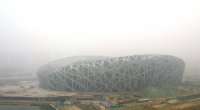Research points to regional strategies to reduce urban air pollution

Records were destined to fall at the 2008 Olympics, but Chinese officials didn't want the gold medal for "most polluted air." Reducing air pollution in an urban area like Beijing will require large, regional strategies according to scientists from Pacific Northwest National Laboratory, Georgia Institute of Technology, and Peking University. They studied the effects of emission reduction efforts at the Beijing Olympics. The results were published in Environmental Science & Technology.
Smog, that brownish mix of nitrogen oxides, ozone, volatile organic compounds, and other noxious pollutants that hangs low over many large cities, is a serious health concern for millions. It contributes to emphysema, bronchitis, and asthma and is especially harmful to people with heart and lung conditions. The sweeping strategies to curtail noxious emissions before and during the 2008 Summer Olympic Games in Beijing presented a unique opportunity for atmospheric scientists to study emissions reduction physics and provide policy makers a basis of information to make future public health decisions.
"The scale of emission controls in Beijing was historic. It is important to study the impacts of these efforts to understand what happened and how we can achieve lower pollution levels," said Dr. Qing Yang, an atmospheric scientist at PNNL and lead author of the research.
Beijing, the famously smog-draped Chinese capital and home to 20 million people, was host to the 2008 Olympic and Paralympic Games, held August 8-24 and September 9-17, respectively. Starting on July 20 of that year, the Chinese government implemented large-scale efforts to reduce air pollution. The Chinese cut vehicle traffic in half, and significantly reduced operations at factories, industrial facilities, and power plants. Outside of Beijing and in neighboring cities, more moderate restrictions were applied.
The study's objectives were twofold. Researchers quantified changes in observed nitrogen dioxide and the corresponding reduction in surface NOx emissions over Beijing. And secondly, they assessed the impacts of NOx and VOC emissions reductions on surface ozone concentrations.
The research team used NOx measurements from Aura, a multi-national NASA scientific research satellite, to provide calibration for simulated NOx concentrations. The team adjusted NOx emissions using an iterative error weighting method within REAM, a three-dimensional global chemical model. This method allowed researchers to estimate emission changes on a more precise daily scale than previous studies, and it demonstrated that improvements in air quality roughly corresponded to the scheduled implementation of emission controls.
Some impacts of radical emissions reduction surprised researchers. During the height of the emission control period, NOx emissions over metropolitan Beijing decreased by 28 percent. However, the reduction of ozone, another atmospheric pollutant, was remarkably low.
"Ozone production is highly complex, so it is important that when emissions are reduced, they are reduced on a regional level and not focused on a limited urban area. It is important to understand these variables, because they help provide a roadmap for more effective emissions strategies from a policy level. This is information that is not just valuable for China, but globally," said Yang.
Ultimately, urban air quality is determined by a number of factors, including human-generated emissions, weather and temperature, geography, and natural VOC emissions from plants and trees.
Researchers plan to integrate multiple satellite observations of ozone and carbon monoxide levels with model simulations to understand air quality response after the aggressive emission controls in Beijing ended.
More information: Yang Q, et al. "NOx Emission Reduction and its Effects on Ozone during the 2008 Olympic Games," 2011. Environmental Science & Technology, 45 (15): 6404-6410. DOI: 10.1021/es200675v
Provided by Pacific Northwest National Laboratory















